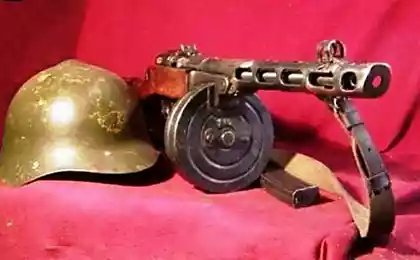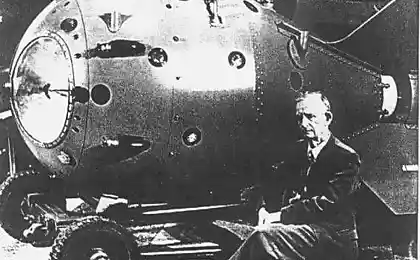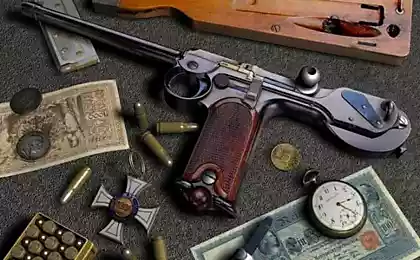790
Feodosia-13: former warehouse of nuclear weapons
Writes blogger frantsouzov: August 29, 1949 has been tested the first Soviet atomic bomb.
All nuclear power plants and the Research Institute of the USSR united by one Ministry of Medium Machine Building (MSM), which was to develop serial production of nuclear warheads. All responsibility for the testing of nuclear weapons, their storage and service in military units, as well as for the development of methods of their combat use of the country's leadership has placed on the military.
At the end of 1950 a special decree of the Council of Ministers had decided to establish a so-called central database storage of nuclear weapons - TSBH. These organizations carried out an assembly produced in factories MSM ammunition stored them, keeping secret the fact of storage, produced if necessary, replace the nodes with the warranty expires storage, test the electronic and mechanical components on special stands and the preparation of a relevant order issued nuclear weapons to the troops for combat use.
22 photos
1. One such TSBH was decided to build in Kiziltashsky Valley, which made it possible to create a reliable protection of the territory, fencing off its mountain ridges from prying eyes. Storage of nuclear weapons could sit comfortably in the interior arrays of the surrounding mountains, which, according to the calculations of experts, would ensure the safety of products even when the power of a nuclear explosion close to ten megatons.

2. It is known that from the very beginning its main nuclear project curated by the country's leadership was appointed People's Commissar of Internal Affairs LP Beria. His rigid principles, selection of business people in the nuclear weapons complex adhered to strictly. Nominations chiefs TSBH consistent personally LP Beria, often he personally visited similar facilities, watched the first test of a nuclear weapon, but Theodosia was not, never.
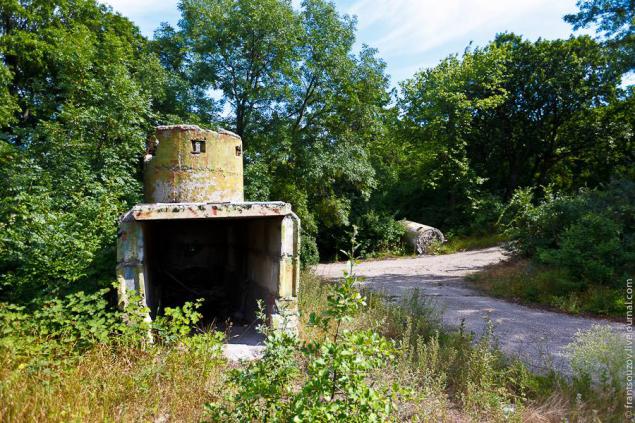
3. In 1951, began a grand building, the first trains were taken to prisoners Kiziltashsky valley and equipment - the best in the Soviet Union and possibly the world. Construction was carried out Glavgorstroem - Special construction management MSM in which senior positions occupied by experienced zemleprohodchiki Metrostroi Leningrad.

4. Outside could be seen only a massive steel gate, which if necessary can be masked from the dense curtain of canvas in the color of the mountains.

5. The entire underground complex of buildings had energy from the outside and from the autonomous power supply emergency diesel generators inside. Climatic parameters in each building is maintained automatically. Each room was carried out radiation control.

6. The rails along which carriage of dangerous goods have taken a long time ago "hunters metal", but to the door to the room for some reason they did not get.

7. Go to the store itself.

8. How hard is responsible, and sometimes harmful was the work of professionals serving the safety of products can be seen in the description of the periodic routine test units of the central parts of the product. These very important operations carried out by officers of the central parts of the storage service. One of the most harmful was checked by hand were part of the first samples of products continuously operating neutron sources such as NO-2 and NT-5B. Sources stored in containers with a wall includes a thick layer of wax, which is called "pots". Each pot was placed in a separate metal safe.

9. In an underground vault where they were safe, the level of neutron radiation was so high that the tungsten filament light bulb burn out normal due to neutron bombardment after 13 minutes. A maximum period of stay of the person in the store should not exceed 43 seconds.
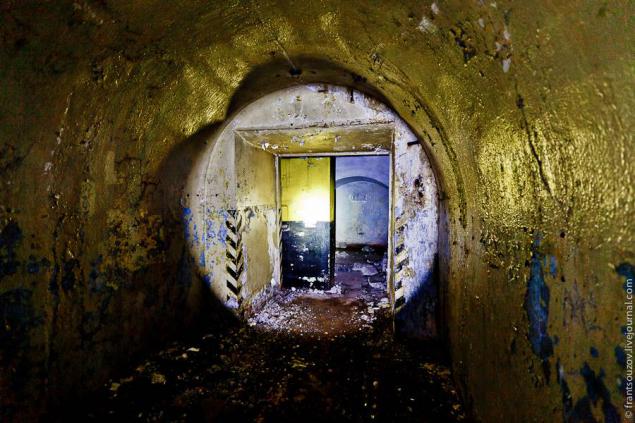
10. Each time one of the officers had to carry with it a new lamp, unscrew and replace burnt it. At this time, two other officers opened safe, took out another "pot" and make it into a corridor where placed on a cart with walls made of wax.

11. The carriage rolled on rather short corridor to the laboratory, where a special table "pot" after inspection dissected, removed the source of his hands and placed on the shelf of a special screen of thick plexiglass, which directly against shelves with source was cast from the same plexiglass magnifier. Through a magnifying glass inspecting the source.

12. Log into the next room.

13. The source itself was a ball of gold a few centimeters in diameter, consisting of two hemispheres connected by seaming seam. Inspection integrity of the seam and was, along with the test weight on the source of special analytical balance, the essence of routine maintenance.

14. To inspect the source behind the screen had to turn gently with one hand while looking at the screen magnifier. In the hands of the Comptroller wore thin white cotton gloves, which, after the rules went into the waste container.

15. After inspecting the source was placed in a "pot", which is sealed and settled down again in the repository. Light bulbs replaced again. All manipulations of the source, as it should be, according to the form on this node.

16. In this work are usually attended by all officers of the central parts of the storage service officers and checkout lab, including the officer dosimetrist. The script works in advance would sign and being followed by seconds. It provided for the interchangeability of working at various stages of the officers to minimize the dose received by neutron irradiation.

17. Nevertheless, the total doses were high enough. Without taking precautions, some officers the next day appeared backfire. But precautions were taken from the tips of Biochemistry and consisted in reducing the number of free radicals produced in the body with fast neutrons, with a liquid containing weakly bound hydroxyl group. As is known, such liquid is ethanol.

18. It should be noted that the dangerous and technically imperfect permanent neutron sources by the early 60s began to be replaced with pulsed neutron sources, devoid of all the negative qualities of their predecessors.

19. Another way out of the store, located a few hundred meters from where we came.

20. As a result of the Belavezha Accords December 8, 1991 in the four former Soviet republics, and to this day - in the sovereign states of the Russian Federation, the Republic of Belarus, the Republic of Ukraine and the Republic of Kazakhstan, there were about 30 thousand nuclear warheads.

21. Fortunately, the leaders of the new republics, assessing their potential, weighing the political, economic and military expediency, after hearing the arguments of Russia and recommendations of the United States, refused to claim ownership of nuclear weapons.

22. They recognized the rightful successor of the USSR in the possession of nuclear weapons Russian Federation. In 1994, US President Bill Clinton arrived in Russia, and during his visit was the signing of a joint US-Russian-Ukrainian agreement under which all nuclear weapons to be removed from Ukraine to Russia. With considerable difficulty the last trains with loads of the 12th Main Directorate of the Ministry of Defence left the Ukraine in June 1996.

Source:
All nuclear power plants and the Research Institute of the USSR united by one Ministry of Medium Machine Building (MSM), which was to develop serial production of nuclear warheads. All responsibility for the testing of nuclear weapons, their storage and service in military units, as well as for the development of methods of their combat use of the country's leadership has placed on the military.
At the end of 1950 a special decree of the Council of Ministers had decided to establish a so-called central database storage of nuclear weapons - TSBH. These organizations carried out an assembly produced in factories MSM ammunition stored them, keeping secret the fact of storage, produced if necessary, replace the nodes with the warranty expires storage, test the electronic and mechanical components on special stands and the preparation of a relevant order issued nuclear weapons to the troops for combat use.
22 photos
1. One such TSBH was decided to build in Kiziltashsky Valley, which made it possible to create a reliable protection of the territory, fencing off its mountain ridges from prying eyes. Storage of nuclear weapons could sit comfortably in the interior arrays of the surrounding mountains, which, according to the calculations of experts, would ensure the safety of products even when the power of a nuclear explosion close to ten megatons.

2. It is known that from the very beginning its main nuclear project curated by the country's leadership was appointed People's Commissar of Internal Affairs LP Beria. His rigid principles, selection of business people in the nuclear weapons complex adhered to strictly. Nominations chiefs TSBH consistent personally LP Beria, often he personally visited similar facilities, watched the first test of a nuclear weapon, but Theodosia was not, never.

3. In 1951, began a grand building, the first trains were taken to prisoners Kiziltashsky valley and equipment - the best in the Soviet Union and possibly the world. Construction was carried out Glavgorstroem - Special construction management MSM in which senior positions occupied by experienced zemleprohodchiki Metrostroi Leningrad.

4. Outside could be seen only a massive steel gate, which if necessary can be masked from the dense curtain of canvas in the color of the mountains.

5. The entire underground complex of buildings had energy from the outside and from the autonomous power supply emergency diesel generators inside. Climatic parameters in each building is maintained automatically. Each room was carried out radiation control.

6. The rails along which carriage of dangerous goods have taken a long time ago "hunters metal", but to the door to the room for some reason they did not get.

7. Go to the store itself.

8. How hard is responsible, and sometimes harmful was the work of professionals serving the safety of products can be seen in the description of the periodic routine test units of the central parts of the product. These very important operations carried out by officers of the central parts of the storage service. One of the most harmful was checked by hand were part of the first samples of products continuously operating neutron sources such as NO-2 and NT-5B. Sources stored in containers with a wall includes a thick layer of wax, which is called "pots". Each pot was placed in a separate metal safe.

9. In an underground vault where they were safe, the level of neutron radiation was so high that the tungsten filament light bulb burn out normal due to neutron bombardment after 13 minutes. A maximum period of stay of the person in the store should not exceed 43 seconds.

10. Each time one of the officers had to carry with it a new lamp, unscrew and replace burnt it. At this time, two other officers opened safe, took out another "pot" and make it into a corridor where placed on a cart with walls made of wax.

11. The carriage rolled on rather short corridor to the laboratory, where a special table "pot" after inspection dissected, removed the source of his hands and placed on the shelf of a special screen of thick plexiglass, which directly against shelves with source was cast from the same plexiglass magnifier. Through a magnifying glass inspecting the source.

12. Log into the next room.

13. The source itself was a ball of gold a few centimeters in diameter, consisting of two hemispheres connected by seaming seam. Inspection integrity of the seam and was, along with the test weight on the source of special analytical balance, the essence of routine maintenance.

14. To inspect the source behind the screen had to turn gently with one hand while looking at the screen magnifier. In the hands of the Comptroller wore thin white cotton gloves, which, after the rules went into the waste container.

15. After inspecting the source was placed in a "pot", which is sealed and settled down again in the repository. Light bulbs replaced again. All manipulations of the source, as it should be, according to the form on this node.

16. In this work are usually attended by all officers of the central parts of the storage service officers and checkout lab, including the officer dosimetrist. The script works in advance would sign and being followed by seconds. It provided for the interchangeability of working at various stages of the officers to minimize the dose received by neutron irradiation.

17. Nevertheless, the total doses were high enough. Without taking precautions, some officers the next day appeared backfire. But precautions were taken from the tips of Biochemistry and consisted in reducing the number of free radicals produced in the body with fast neutrons, with a liquid containing weakly bound hydroxyl group. As is known, such liquid is ethanol.

18. It should be noted that the dangerous and technically imperfect permanent neutron sources by the early 60s began to be replaced with pulsed neutron sources, devoid of all the negative qualities of their predecessors.

19. Another way out of the store, located a few hundred meters from where we came.

20. As a result of the Belavezha Accords December 8, 1991 in the four former Soviet republics, and to this day - in the sovereign states of the Russian Federation, the Republic of Belarus, the Republic of Ukraine and the Republic of Kazakhstan, there were about 30 thousand nuclear warheads.

21. Fortunately, the leaders of the new republics, assessing their potential, weighing the political, economic and military expediency, after hearing the arguments of Russia and recommendations of the United States, refused to claim ownership of nuclear weapons.

22. They recognized the rightful successor of the USSR in the possession of nuclear weapons Russian Federation. In 1994, US President Bill Clinton arrived in Russia, and during his visit was the signing of a joint US-Russian-Ukrainian agreement under which all nuclear weapons to be removed from Ukraine to Russia. With considerable difficulty the last trains with loads of the 12th Main Directorate of the Ministry of Defence left the Ukraine in June 1996.

Source:


